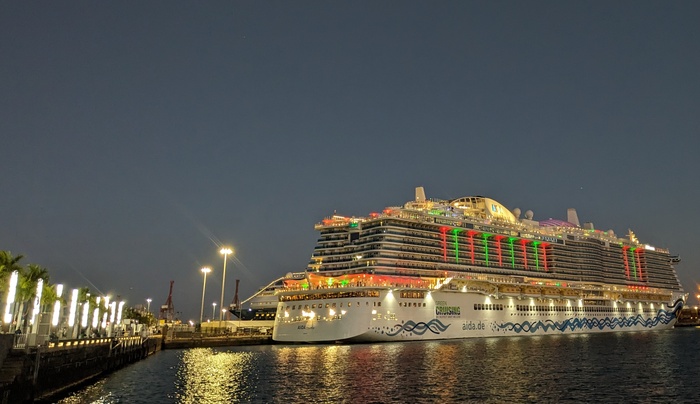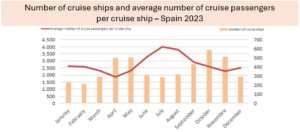Cruise lines: its passenger figures in 2023 and its changes and trends over the last year and since the pandemic

A record year that reached 12 million cruise passengers in Spain
- Cruise passenger traffic increases by 46% during 2022, with Andalusia (62%) and Catalonia (52%) standing out above the average.
- The figures exceed pre-pandemic levels by 12%. The Region of Valencia stands out as the one that improves the 2019 figures by far (95%) and the Balearic Islands is the only major recipient of cruise ship traffic that is yet to recover to the pre-pandemic figures.
According to the latest figures, the year 2023 has been a year of widespread recovery for the cruise sector in Spain. In total, there have been more than 11.96 million cruise passengers of the nearly 4,500 cruise ships received. This indicates that an average of 2,668 passengers were received per cruise ship, increasing the passenger figures by more than 30% compared to 2022 and by nearly 5% compared to 2019. Data is available on Dataestur's dashboard that includes statistics from Ministry of Transport and Sustainable Mobility of Spain.
The increase in cruise passengers compared to 2022 has been constant throughout the year and continues along those lines at the beginning of 2024 (around 7% compared to 2023 in the months of January and February). In addition, the passenger figures of the spring season have recovered well, which were still far from the pre-pandemic figures. This makes it possible for over seven months (between May and November) to exceed one million cruise passengers in Spain, something that only happened in October 2022. It is precisely the month of October that consolidates as the one receiving the most passenger traffic.
Cruise traffic in Spain concentrates in two key areas: the Mediterranean Sea and the Canary Islands. The Mediterranean Sea concentrates the majority of traffic and, in particular, the port authorities of Barcelona and the Balearic Islands accounted for half of the cruise passenger traffic in 2023. In fact, the cruise ship figures far exceed the national average number of passengers: Catalonia by almost 60% (more than 4,200 cruise passengers per cruise ship) and the Balearic Islands by almost 25% (up to around 3,300 passengers per cruise ship).
The Mediterranean adds two other important hubs in Valencia (6.6% of cruise passenger traffic) and Malaga (4.2%). Moreover, the Canary Islands concentrate just over 20% of cruise passenger traffic with the port authorities of Las Palmas (12.6%) and Santa Cruz de Tenerife (9.2%), being also the only region that received more than 1,000 cruise ships in 2023.
The Bay of Cádiz and Galicia each received 5% of Spain's cruise passengers in 2023.
Broadly speaking, the cruise ships with the most passengers arrive in Spain in the summer months and usually coincide with the arrival of a smaller number of cruise ships.
Below are the figures for cruise passengers in 2023 from the autonomous communities with the most cruise ship traffic, as well as the changes and trends of the last year and when compared to 2019.

Catalonia, 6-month season, concentrated in Barcelona
The port of Barcelona is Spain's most important port in terms of international traffic and concentrates practically all cruise passengers in the region (around 97% in 2023). The year closed with more than 3.6 million cruise passengers and 861 cruise ships received. Therefore, despite the fact that there were only two fewer cruise ships than in 2019, the average number of passengers was greater than 4,200 (11% more than the average in 2019, 3,790 passengers).
Passenger traffic is mainly in the form of cruise passengers in Catalonia (68% of the annual total). Only in August, it comes close to only half of this figure. In the months of October, November and May, cruise passengers represent at least 80% of the region's maritime passenger traffic.

The number of cruise passengers in 2023 increased by more than 50% when compared to the 2022 figure, with a large concentration in the months of April, May and June. The cruise season is concentrated between May and October. During these months, the figures were of over 400,000 cruise passengers (something that only happened in August and September 2019 and which did not happen throughout 2022).
The Canary Islands, the winter cruise destination with a season of almost six months
This is the second most important autonomous region in terms of volume of cruise passengers, being the destination of just over one in five cruise passengers in Spain. In 2023, it exceeded 2.6 million cruise passengers and has practically doubled its high cruise season to six months compared to 2022, recovering its pre-pandemic figures.

It stands out as the autonomous region that will receive the most cruise ships in 2023, being the only one that exceeds 1,000 (30% more than in 2019, but below the nearly 1,300 it received in 2022). Its average occupancy in the last year exceeds 2,400 passengers per cruise ship, a figure that is over 20% less than the pre-pandemic figures.
Its cruise season is practically the opposite of that of Mediterranean destinations, mainly between November and March, with more than 350,000 passengers per month. The months of December stand out (450,000 cruise passengers last year) and November and March (around 400,000). These cruise passengers are distributed between the ports of the port authority of Las Palmas (just over 55%) and the port authority of Santa Cruz de Tenerife. In addition, a special feature of the archipelago's maritime traffic means that cruise passengers only account for one in every four maritime passengers on the islands, achieving a greater relevance during their high season (around 40%) and being practically non-existent in the summer months.
The Balearic Islands, the only major cruise ship destination that is yet to recover its 2019 figures
Despite exceeding 2.5 million cruise passengers in 2023 and increasing the numbers for 2022 by around 45%, the Balearic Islands are yet to recover the pre-pandemic numbers of cruise passengers. It is around 5% lower, mainly due to the summer months, and gives way to the Canary Islands as the second autonomous community with the most cruise passengers.

On a positive note, the 2023 figures show recovery of the spring months, which allows the season to be extended again to six months (between May and October). During this period, there are more than 300,000 cruise passengers, something that did not happen during 2022.
Cruise passenger traffic in the Balearic Islands accounts for 25% of the annual maritime passenger traffic of its ports. Only in October, November and May does cruise traffic move in clearly higher figures, around 35%.
Andalusia, two short seasons in spring and autumn with growth in between
In 2023, it surpassed one million cruise passengers for the first time, reaching 1.24 mainly between the port authorities of the Bay of Cadiz (54%) and Málaga (40%). The past year greatly improves upon the figures of 2022 and by up to 25% of the figures before the pandemic, especially due to the growth in cruise passengers during the months of July and August. In addition, it is the only region in which there were more cruise ships last year than in previous years.

Its peak cruise season is in October and November, with almost 200,000 cruise passengers per month. However, a second season was clearly identified in April and May of the year 2019, but 2023 blurs the second season with the increases in cruise passenger arrivals in summer, which reduces the off-peak season almost only to the month of June.
The relevance of cruise passenger traffic in the overall maritime passenger traffic in Andalusia is barely 15% of the total, although this is four points more than in 2019. In fact, in October, cruise passengers accounted for more than 30% of maritime passengers and they approached 40% in November.
The Region of Valencia doubles the 2019 traffic figures and joins the Mediterranean season
This is the region that has grown the most in terms of cruise passengers since 2019, practically doubling its numbers and reaching one million cruise passengers for the first time in 2023. It is still quite far from reaching the traffic figures of Catalonia and the Balearic Islands, but the number of cruise ships has increased significantly between May and November, becoming a relevant destination in the high cruise season in the Spanish Mediterranean.

In the last year, the average number of passengers per cruise has also grown by much, close to 40%, reaching more than 2,750 cruise passengers per cruise ship.
The vast majority of cruise traffic concentrates in Valencia (80% of cruise passengers in the region in 2023), but in recent years, Alicante has grown the most, tripling its cruise passengers in 2019 and increasing its representation in the community by more than 7 points, accounting for 20% of cruise passenger traffic. Proof of the growth in the volume of cruise passengers is the increase in relevance of maritime passenger traffic. In 2023, cruise passengers represented the majority (51%) of maritime passengers in the Region of Valencia (13 points more than in 2019 and representing up to 74% in the month of October).




